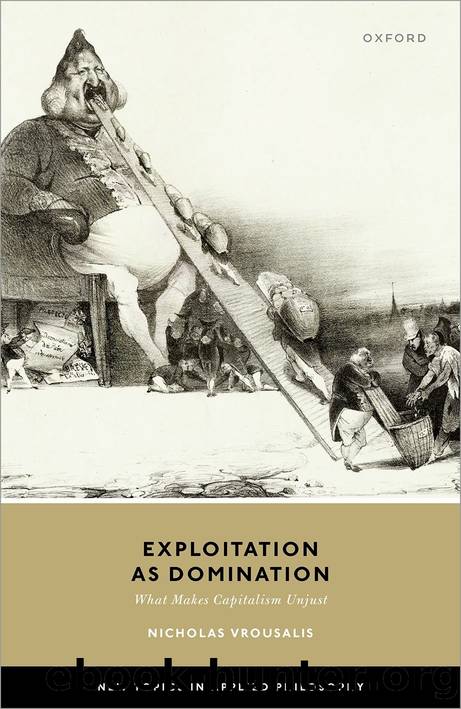Exploitation As Domination by Nicholas Vrousalis;

Author:Nicholas Vrousalis; [Vrousalis, Nicholas]
Language: eng
Format: epub
ISBN: 9780192693549
Publisher: Oxford University Press USA
Published: 2022-10-27T00:00:00+00:00
4.4 How Capitalists Dominate
This section builds on Chapters 2 and 3 to explain how capital dominates labour under capitalism. âCapitalismâ, it bears repeating, designates the structure discussed in Chapter 2: unequal private ownership of scarce productive assets, along with a labour or credit market conferring access to these means. I begin by discussing the nature of the abstract relation between capital and labour. In section 4.5, I explain how the addition of the state imparts structure to that relation, that is, makes capitalist domination a form of structural domination.
Consider:
Interagential Capitalist DominationâCapital has money, Labour does not. Labour needs means of consumption, which she cannot obtain without money. So Labour places her labour power at Capitalâs disposal, in return for money. Capital appropriates the product of Labourâs labour, sells it for money, returns half the money to Labour, and pockets the other half as profit.
This interagential relation involves monetized unilateral control over alien purposiveness. On this description, capital is not fundamentally a property or class relation, although it presupposes both private property and class division.21 So private property can co-constitute the capital relation without being identical with or reducible to that relation.22 Rather, the capital relation is, fundamentally, a form of reification: the relation confers upon Capital unilateral control over Labourâs labour power in the form of a relation between the things that each of Capital and Labour own. This control, in turn, enables Capital to exploit Labour. So it is reification that makes the capital relation conceptually and historically distinctive.23
I now explain why Interagential capitalist domination involves domination. The general idea was explained in Chapter 2 and goes as follows. Suppose that omelettes are the only means of consumption and that, if Labour is to nourish herself, she must produce an omelette. As long as Capital owns the eggs, Labour can produce the omelette only by Capitalâs permission. This makes Labourâs ability to set and pursue the end of omelette productionâher productive purposivenessâsubordinate to Capitalâs unilateral will. When that subordination is expressed in extraction of unilateral labour flow, moreover, Capital exploits Labour.24
This generic description suggests a double bind of capital similar to that of the patriarchy. Just as women under the patriarchy must choose between being excluded from familial or sexual relations and participating on terms set out unilaterally by men as a whole, so workers under capitalism must choose between being excluded from work altogether and working at the unilateral discretion of the capitalists as a whole. This makes capitalism, patriarchy, and white supremacy structurally homologous: all three restrict the choice sets of the subaltern to a dilemma between social abstinence and domination. The worker under capitalism, the woman under patriarchy, and the nonwhite person under white supremacy are all dominated in that sense.
I now explain how the abstract relation in Interagential Capitalist Domination becomes structural. The missing third relatum, I argue, is the capitalist state.
Download
This site does not store any files on its server. We only index and link to content provided by other sites. Please contact the content providers to delete copyright contents if any and email us, we'll remove relevant links or contents immediately.
Verus Israel: Study of the Relations Between Christians and Jews in the Roman Empire, AD 135-425 by Marcel Simon(549)
Infocracy by Byung-Chul Han(532)
Caesar Rules: The Emperor in the Changing Roman World (c. 50 BC â AD 565) by Olivier Hekster(526)
Europe, Strategy and Armed Forces by Sven Biscop Jo Coelmont(477)
Banned in the U.S.A. : A Reference Guide to Book Censorship in Schools and Public Libraries by Herbert N. Foerstel(444)
Reading Colonial Japan by Mason Michele;Lee Helen;(441)
Give Me Liberty, Seventh Edition by Foner Eric & DuVal Kathleen & McGirr Lisa(435)
The Roman World 44 BC-AD 180 by Martin Goodman(434)
DS001-THE MAN OF BRONZE by J.R.A(419)
The Dangerous Life and Ideas of Diogenes the Cynic by Jean-Manuel Roubineau(417)
The Oxford History of World War II by Richard Overy(414)
Imperial Rome AD 193 - 284 by Ando Clifford(407)
Introducing Christian Ethics by Samuel Wells and Ben Quash with Rebekah Eklund(407)
american english file 1 student book 3rd edition by Unknown(402)
Basic japanese A grammar and workbook by Unknown(380)
Literary Mathematics by Michael Gavin;(373)
Language Hacking Mandarin by Benny Lewis & Dr. Licheng Gu(351)
The Oxford History of the Renaissance by Campbell Gordon;(331)
How to Reach the 9.0 in IELTS Academic Reading by IELTS Medical(331)
